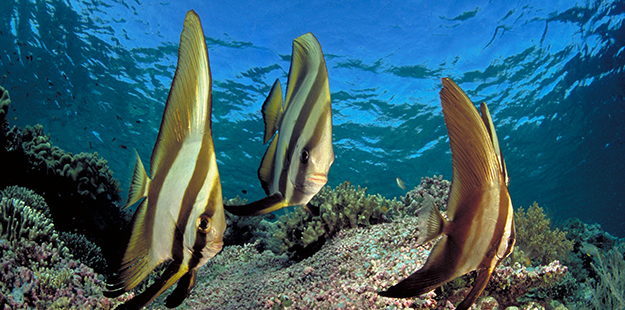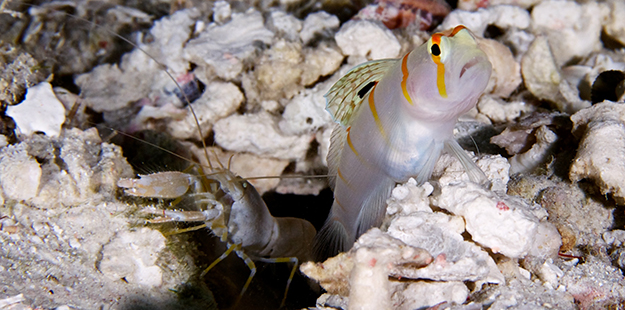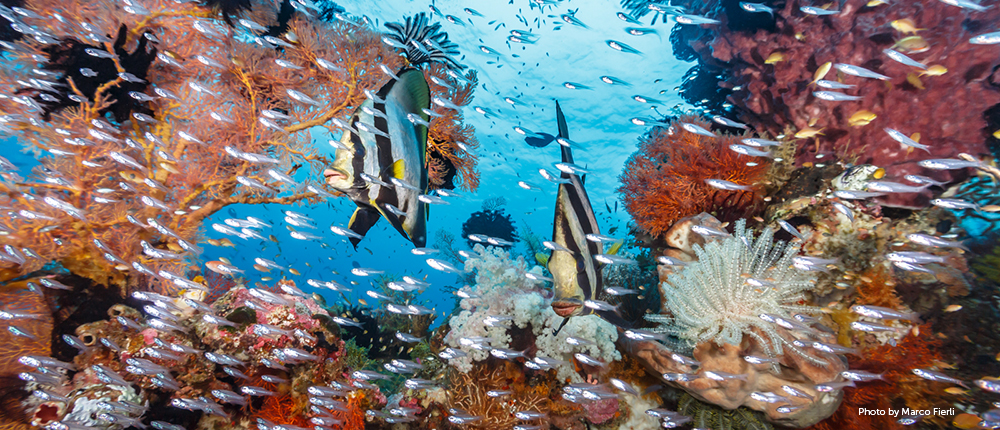The Magnificent Seven
Table Coral City
It’s easy to see how this site got its name. The crest of this prominent sea mound is decorated with large, dining table sized coral growths, with broad tops that balance on slender supporting columns. Interspersed among these formations are groves of staghorn and cabbage coral.
In contrast, the sides of the pinnacle are covered in colorful sprays of sponges and gorgonians. The entire formation is a fish magnet; the peak is covered in swirling masses of anthias, pyramid butterflyfish, fusiliers and soldierfish.

Trevally jack are commonly seen making their circling passes around Table Coral City. Photo by Norbert Probst
Schools of blackfin barracudas circle the mound; eagle rays and turtles glide by while snapper and giant trevally patrol the reef. Keen-eyed critter hunters will unveil a range of ambush predators that includes lizardfish, leaf scorpionfish, and crocodilefish, while closer scrutiny will reveal tiny treasures such as bubble coral shrimp and orangutang crabs
Blade
Blade is a unique dive site and the furthest site regularly visited by the resort’s day boats. Divers agree that the longer boat ride needed to reach Blade is well justified by what awaits. This distinct formation consists of a row of elongated parallel seamounts that rise from a deeper ridge to within two meters of the surface.

From above divers can actually see down both sides of the formation at the same time giving rise to why this site is called Blade. Photo by Walt Stearns
When seen in profile, the entire formation resembles the serrated teeth of a giant knife set on edge, hence its name. The individual pinnacles are long but quite narrow. Divers drifting close to the surface can actually view both sides of the formations simultaneously from above. Blade is about as picturesque as it gets, complete with colorful arrays of giant sponges and sea fans that can at times grow to upwards of 6 – 10 feet (2 – 3 m) across.

A brilliant collection of sponges and gorgonians line the top of Blade’s ridgeline. Photo by Walt Stearns
Red whip corals grow thick on the steep sides of each pinnacle, providing fantastic photo opportunities. Multi-hued crinoids can often be seen perched on the tips of gorgonians, extending their tentacles to catch passing morsels of food. Mild currents allow divers to drift from peak to peak, evoking a sensation of weightless flight. All in all, Blade is an experience not soon forgotten.
Learn more here > Blade: Diving the Edge
Teluk Maya
This site gets top marks for diversity, as it offers a wide range of depths and a mixture of underwater environments, all in close proximity. A series of shallow coral formations rising almost to the surface surround a sandy bay decorated with coral heads and patches of seagrass. At its open seaward side, the bay transitions from a slope to a wall, with steep overhangs that shelter reclusive marine life and groves of black coral. Within the bay, there’s a lot going on. A large school of resident batfish mill about, hunting for morsels in the sand or waiting their turn at cleaning stations.

Batfish mill around the bay at Teluk Maya hunting for morsels of food and posing for the camera. Photo by Werner Thiele
Cuttlefish frequent Teluk Maya for mating and nesting. Females can often be seen gathering sperm packets from suitors, then moving to a sheltered area to fertilize and encapsulate a clutch of eggs in a sepia-colored envelope. Razorfish and rockmover wrasse go about the business of building burrows while colorful nudibranchs inch their way through the seagrass and coral.

Wakatobi’s dive guides love Teluk Maya as much as the guests as the site is a prime area for rare finds such as the solar powered nudibranch. Photo by Rob Darmanin
Teluk Maya is a prime area to discover one of the most celebrated of sea slugs, the solar powered nudibranch. This large invertebrate adds variety to its diet of leather corals by cultivating colonies of zooxanthellae algae in its elongated tentacles. The nutrients the algae create through photosynthesis are shared with the nudibranch.
Cornucopia
Many of the shallow reefs around Wakatobi Resort transition to steep walls, often just a couple of meters from the surface. One of the most popular of these precipices is the Great Wall of Cornucopia, which combines a dramatic vertical profile with an above-average critter count. As the reef goes vertical, the face is adorned with the multi-hued coatings of soft corals typical of walls in this area.

Cornucopia combines a dramatic vertical profile with an above-average critter count. Photo by Marco Fierli, marcof8.com
Closer to the surface, dense clusters of mid-sized sea fans dominate. At greater depths, larger and more solitary gorgonians mix with sponges and black coral groves. What sets Cornucopia apart are the numerous undercuts that perforate the wall. These sheltering enclaves provide a home to comet fish, juvenile grouper and a range of macro life. A signature resident of these grottoes is Randal’s shrimp goby. Unlike other shrimp gobies, which almost exclusively inhabit open sandy or silty bottoms, Randal’s prefer these overhead environments indenting Cornucopia’s wall.

Sheltering enclaves at Cornucopia provide a home to a range of macro life such as Randal’s shrimp goby. Photo by Frank Owens
These small orange-and-white banded fish are usually found in the company of a similarly colored alpheid shrimp that have a cooperative living arrangement. The goby stands watch, perched out front of the burrow in its never-ending vigilance for unwanted predators that would like to make it’s nearsighted crustacean companion a meal, while the shrimp handles all the housekeeping.
There are more than 40 additional dive sites located within the private marine reserve that surrounds Wakatobi Resort. Profiles range from snorkel depths to technical diving depths and host a roster of marine life that is among the most plentiful and diverse of any ocean. A unique combination of protection, diversity, and accessibility has made the Wakatobi region one of the planet’s most sought-after diving destinations. And the icing on the cake is Wakatobi Resort itself, which offers five-star service, gourmet dining and casually elegant accommodations, all set in an idyllic location.
Contact us at office@wakatobi.com or complete a quick trip inquiry at wakatobi.com.
Visit us on Facebook



